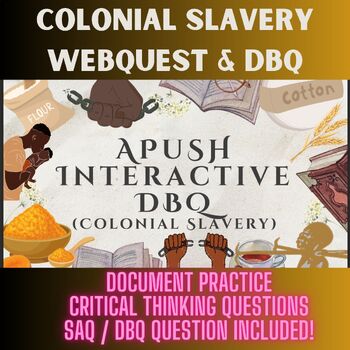Also included in
- Save yourself hundreds of hours of prep-work with this no-prep AP US History Complete Curriculum of Lecture Presentations and more! These lecture presentations includes an entire year's worth of in-depth notes that covers everything your students need to know on all the topics of the AP US HistoryPrice $99.99Original Price $128.00Save $28.01
Description
Easily Adaptable For Any Social Studies Class!
This FREE resource uses the outstanding website about Early American Colonial Slavery known as "People not Property" sponsored by the Historic Hudson Valley. This program focuses on teaching students about Colonial Slavery IN THE NORTH. We so often teach about slavery in the south that we tend to forget about the thousands of slaves in the NORTH.
This WebQuest is a PDF with clickable links to the People Not Property website and videos. Each slide is treated like a document where the student will click through to the website and answer learning discussion questions on a separate piece of paper OR can be done in a class discussion format. There are a total of 10 document slides with 5-10 questions on each slide.
Although this WebQuest culminates in an AP US History style SAQ (short answer questions) and a DBQ (document based question) essay, it can be used for any US History class. Students will take the information they learned to answer 3 short answer questions and write a final essay if the teacher wishes to assign as a final assessment.
This will take several days to complete (3 class days for me!) to learn about how much slavery existed in the north and how it was both the same and different to slavery used in the south.
**This file now includes a GUIDED NOTE SHEET where students can write their answers as they follow along**
Read This Amazing Teacher Review:
TEACHER, September 24th, 2023
"I recently had the opportunity to engage with a digital Document-Based Question (DBQ) on the topic of slavery, and I must say that it was an incredibly enlightening and transformative experience. Here are some key reasons why I found this digital DBQ to be exceptional:
Rich and Diverse Primary Sources: The DBQ was meticulously curated with a diverse range of primary sources, including letters, diaries, speeches, and visual materials from different historical perspectives. This diversity allowed for a comprehensive exploration of the complex issue of slavery.
User-Friendly Platform: The digital platform was intuitive and user-friendly, making it easy to navigate through the documents, zoom in on details, and access additional historical context. It felt like a seamless journey through history.
Interactive Features: The DBQ came to life with interactive features such as interactive maps, timelines, and multimedia elements. These features enriched the learning experience and helped me visualize the historical context.
Critical Thinking Prompts: Each document was accompanied by thoughtful critical thinking prompts that encouraged deeper analysis and reflection. These prompts challenged me to think critically about the perspectives, biases, and implications of the sources.
Historical Context: The digital DBQ provided comprehensive historical context for each document, allowing me to understand the broader social, political, and economic factors that influenced the perspectives presented. Accessibility: I appreciated that the platform was accessible from various devices, allowing me to study and engage with the materials at my convenience, whether I was at home or on the go.
Student-Friendly: As a student, this digital DBQ felt tailor-made for my needs. It struck a balance between being educational and engaging, which is often hard to find in educational resources. In-Depth Analysis: The DBQ encouraged in-depth analysis and critical thinking rather than surface-level memorization. This approach made learning about slavery more meaningful and impactful. Teacher Resources: I noticed that there were additional teacher resources available, which is a testament to the comprehensive nature of the platform. It's clear that educators can use this tool effectively in their classrooms.
In conclusion, the digital DBQ on slavery was a remarkable educational resource that not only enhanced my understanding of this critical period in history but also fostered critical thinking and empathy. It's a testament to the power of digital tools in education and a valuable resource for anyone interested in learning about slavery and its historical context."
Starting to teach AP US History Period 1 material soon? Check out my Period 1 Bundle that includes everything you need for your first unit HERE






